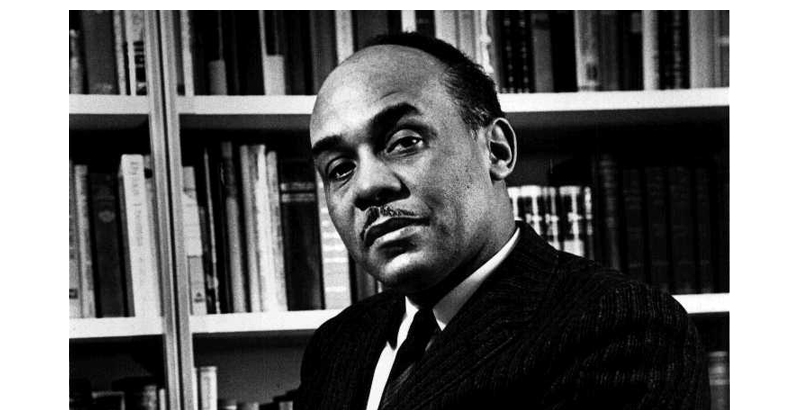
Although there is an extraordinary, Gatsby-like capacity for hope exhibited in Ralph Ellison’s work, optimism is certainly the wrong word for it. In fact, Ellison’s version is propped up by the flying buttresses of both tragedy and comedy. It swings wildly between the two, like the swinging rhythms of jazz in Stanley Crouch’s eloquent description:
‘What I refer to is the expression of sorrow or melancholy in a melodic line that is contrasted by a jaunty or exuberant rhythm, that combination of grace and intensity we know as swing. In jazz, sorrow rhythmically transforms itself into joy, which is perhaps the point of the music: joy earned or arrived at through performance, through creation.’
In identifying these oscillations of sorrow and exuberance in jazz, Crouch taps into what Ellison named “soul.” Crouch essentially parses and explains Ellison’s grammar of soul, noting the way a high-spirited rhythm can transform a melancholic line into a stirring and uplifting performance.
Here and elsewhere, Crouch takes cues from Ellison on when and how to add tragic and comic elements in the right proportions. An excessive focus on one element could ruin the rhythm. If tragic lessons are erased from memory, we end up with banal and artificial sounds, like elevator music, a ditty for advertising, or the most trifling forms of pop music; at the same time, without the comic sense we will be left with cheerless and drab sounds, music that turns the living soul into stone and causes it to sink and drown in gloom. For the soul to grow to its fullest temple-like potential, Ellison required elements of each: the comic sense would be a leavening grace to lighten the gravity of suffering, allowing the American soul to rise to its fullest potential. With both ingredients in the right balance, soul is attained, a kind of multigrain bread of life.
Ellison defined soul as such: “It is its ability to articulate this tragic-comic attitude toward life that explains much of the mysterious power and attractiveness of that quality of Negro American style known as ‘soul.’ An expression of American diversity within unity, of blackness with whiteness, soul announces the presence of a creative struggle against the realities of existence.” As we can see here, Ellison’s concept of soul is born from the conjunction of tragedy and comedy; it skates and slides between the two like the careening legs of James Brown, carrying us from the Apollo Theater to the church, from barrelhouses to the bedroom. In the process—one of the many lessons of the resilient history of black music in America—it displays, even flaunts, an existential toughness and ability to survive no matter the troubles it sees. It’s no wonder that Ellison speaks of an “apprenticeship” when educating us on soul: “Here it is more meaningful to speak, not of courses of study, of grades and degrees, but of apprenticeship, ordeals, initiation ceremonies, of rebirth.”
As an apprenticeship and initiation by fire, soul cannot be achieved in a scholastic manner; it requires the kind of verve, daring, courage, resilience, and shrewdness shown by the main character in Ellison’s Invisible Man. Though the protagonist is a scholarship recipient, his real education occurs outside the walls of the university, in the course of the numerous “battles royal” and contests of nerve that mark his life. He ends up living in an underground room—he speaks of being “clubbed into the cellar,” in point of fact—and must find his voice and perspective in this confined basement.
The narrative begs for allegorical elaboration. Whether one is driven into the underground like this young man or ingested by a whale like Jonah, Ellison implies that being black in America automatically puts one in the darkest dungeons of life, so that the gestation of soul will have to occur in Sheol-like spaces, in the face of death. Thus, there is a sepulchral or mausoleum-like quality to the cellar that Ellison’s invisible protagonist must enter and endure before he can be reborn, as if he were a seed that must fall and sink into the earth before germinating and blooming. (Early Christian baptisteries were shaped like mausoleums with this exact logic in mind.)
Besides possessing this phoenix-like ability to raise black lives from the ashes, Ellison’s concept of soul also casts a dark shadow over the American psyche. By speaking from the American underground, Ellison adds a blues-like color and prophetic edge to his concept of soul; it is a force of dissent against vain and jingoistic versions of American greatness. Ellison’s “soul” is not unlike biblical understandings—vital spirit, life force, or essential self—but he clearly adds the particular shibboleths of black history and culture to the religious account. Consistent with many romantic portraits, “soul” is accordingly a vital spirit and life force but now applied to African American traditions, a symbol of the “spirit of a race,” to quote José Vasconcelos (1882–1959).
(…)

